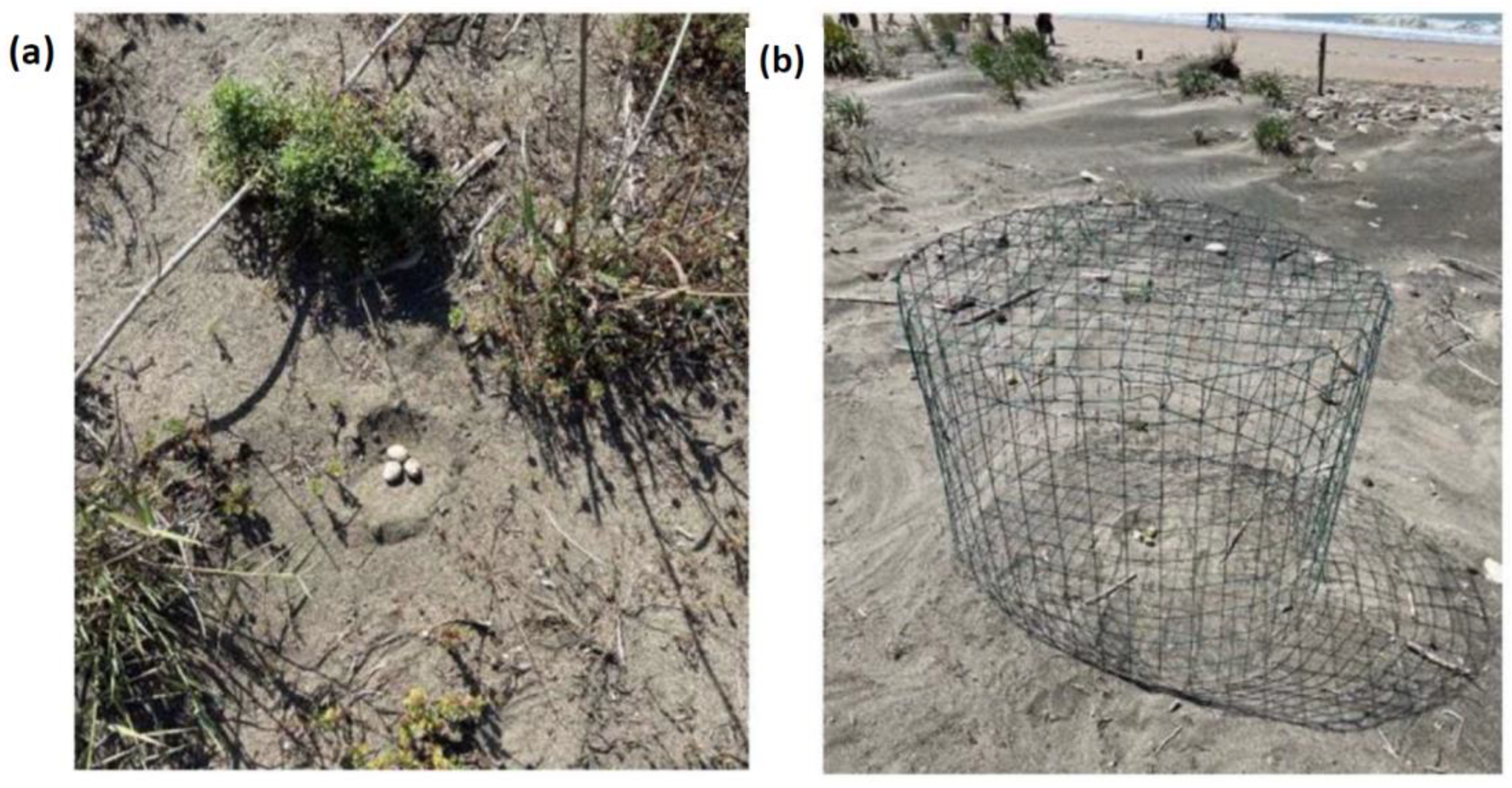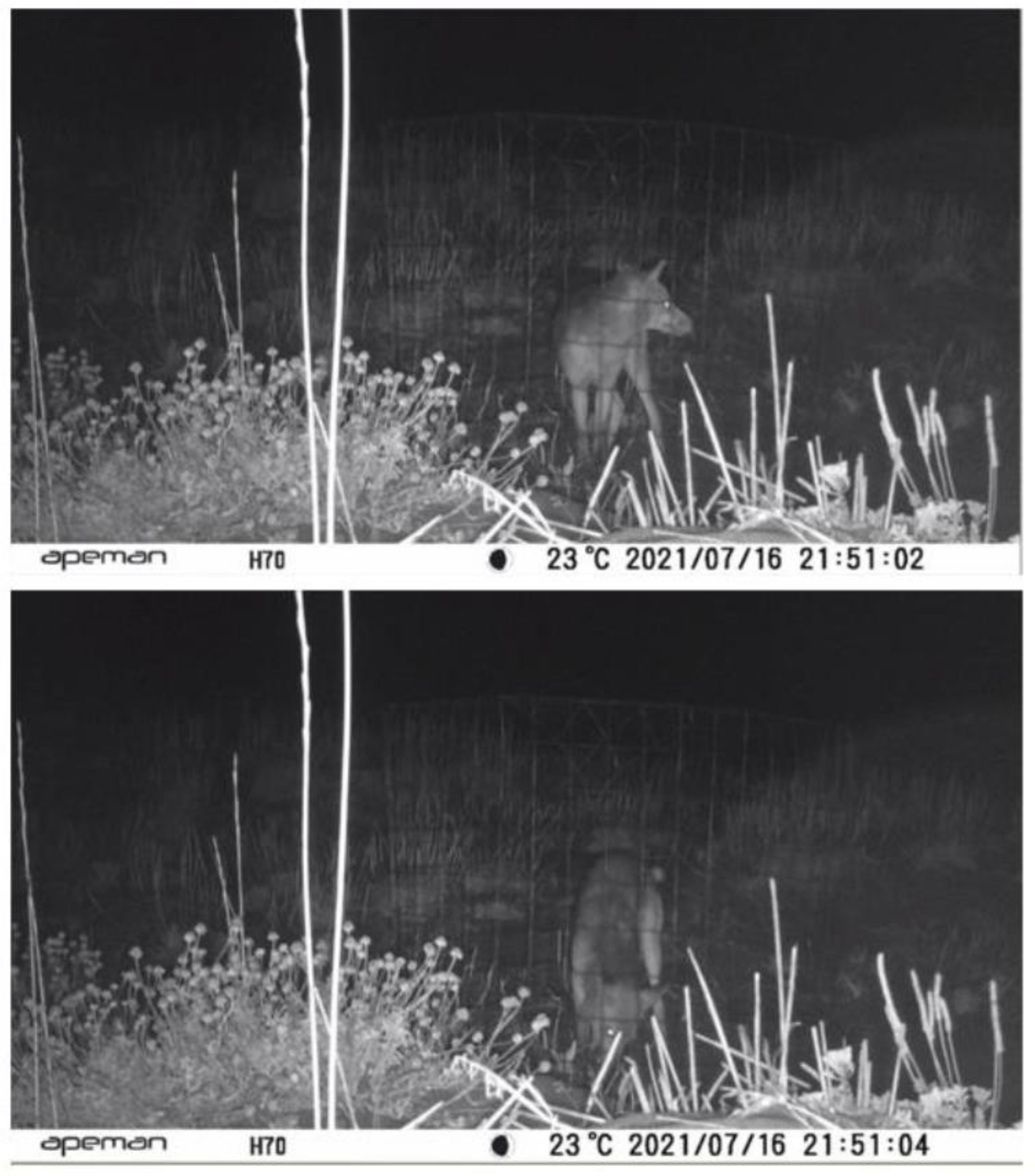Cages Mitigate Predation on Eggs of Threatened Shorebirds: A Manipulative-Control Study
Abstract
:1. Introduction
2. Materials and Methods
2.1. Study Area
2.2. Experimental Design and Data Analyses
3. Results
4. Discussion
Author Contributions
Funding
Institutional Review Board Statement
Informed Consent Statement
Data Availability Statement
Acknowledgments
Conflicts of Interest
References
- Faria, N.; Morales, M.B.; Rabaça, J.E. Exploring nest destruction and bird mortality in mown Mediterranean dry grasslands: An increasing threat to grassland bird conservation. Eur. J. Wildl. Res. 2016, 62, 663–671. [Google Scholar] [CrossRef]
- Mori, E.; Lazzeri, L.; Ferretti, F.; Gordigiani, L.; Rubolini, D. The wild boar Sus scrofa as a threat to ground-nesting bird species: An artificial nest experiment. J. Zool. 2021, 314, 311–320. [Google Scholar] [CrossRef]
- Smith, S.B.; McKay, J.E.; Richardson, J.K.; Shipley, A.A.; Murphy, M.T. Demography of a ground nesting bird in an urban system: Are populations self-sustaining? Urban Ecosyst. 2016, 19, 577–598. [Google Scholar] [CrossRef]
- Burger, J. Beach recreation and nesting birds. In Wildlife and Recreationists: Coexistence through Management and Research; Island Press: Washington, DC, USA, 1995; pp. 281–295. [Google Scholar]
- Rees, J.D.; Webb, J.K.; Crowther, M.S.; Letnic, M. Ravens are a key threat to beach-nesting birds. Austral. Field Ornith. 2015, 32, 100–107. [Google Scholar]
- Ferreira-Rodríguez, N.; Pombal, M.A. Predation pressure on the hatching of the Kentish plover (Charadrius alexandrinus) in clutch protection projects: A case study in north Portugal. Wildl. Res. 2018, 45, 55–63. [Google Scholar] [CrossRef]
- Pietrelli, L.; Biondi, M. Long term reproduction data of Kentish Plover Charadrius alexandrinus along a Mediterranean coast. Bull.-Wader Study Group 2012, 119, 114–119. [Google Scholar]
- Biondi, M.; De Vita, S.; Pietrelli, L.; Muratore, S.; De Giacomo, U.; Valenti, D.; Landucci, G. Monitoraggio riproduttivo delle popolazioni costiere di Fratino Charadrius alexandrinus e Corriere piccolo Charadrius dubius nel Lazio (2014). Gli Uccelli D’Italia 2014, 39, 35–40. [Google Scholar]
- Montalvo, T.; Figuerola, J. The distribution and conservation of the Kentish Plover Charadrius alexandrinus in Catalonia. Rev. Catalana D’ornitologia 2006, 22, 1–8. [Google Scholar]
- Galasso, P.; Spinella, G.; Zafarana, M.A.; Barbera, A.; Cusmano, A.; Cumbo, G.; D’Amico, D.; Grimaldi, D.; Ientile, R.; Laspina, F.; et al. Status, distribution and conservation of Kentish plover Charadrius alexandrinus (Aves, Charadriiformes) in Sicily. Nat. Hist. Sci. 2021, 9, 51–62. [Google Scholar] [CrossRef]
- Gómez-Serrano, M.Á.; López-López, P. Nest site selection by Kentish plover suggests a trade-off between nest-crypsis and predator detection strategies. PLoS ONE 2014, 9, e107121. [Google Scholar] [CrossRef]
- Gómez-Serrano, M.Á. Four-legged foes: Dogs disturb nesting plovers more than people do on tourist beaches. Ibis 2021, 163, 338–352. [Google Scholar] [CrossRef]
- Johnson, M.; Oring, L.W. Are nest exclosures an effective tool in plover conservation? Waterbirds 2002, 25, 184–190. [Google Scholar] [CrossRef]
- Gulickx, M.M.C.; Kemp, J.B. Provision of nest cages to reduce little ringed plover Charadrius dubius nest predation at Welney, Norfolk, England. Conserv. Evid. 2007, 4, 30–32. [Google Scholar]
- Isaksson, D.; Wallander, J.; Larsson, M. Managing predation on ground-nesting birds: The effectiveness of nest enclosures. Biol. Conserv. 2007, 136, 136–142. [Google Scholar] [CrossRef] [Green Version]
- Battisti, C. (Ed.) Biodiversità, Gestione, Conservazione di Un’area Umida del Litorale Tirrenico: La Palude di Torre Flavia; Gangemi Editore–Provincia di Roma, Assessorato alle Politiche Agricole e Dell’ambiente: Rome, Italy, 2006; 496p. [Google Scholar]
- Ioni, S.; Battisti, C.; Fanelli, G. Mapping vegetation dynamics on embryonic sand dunes: A fine-grained atlas for periodic plant monitoring in a Mediterranean protected area. Quad. Mus. Civ. St. Nat. Ferrara 2020, 8, 37–42. [Google Scholar]
- Battisti, C.; Cento, M.; Fraticelli, F.; Hueting, S.; Muratore, S. Vertebrates in the “Palude di Torre Flavia” Special Protection Area (Lazio, central Italy): An updated checklist. Nat. Hist. Sci. 2021, 8, 3–28. [Google Scholar] [CrossRef]
- Battisti, C.; Luiselli, L.; Pantano, D.; Teofili, C. On threats analysis approach applied to a Mediterranean remnant wetland: Is the assessment of human-induced threats related into different level of expertise of respondents? Biodiv. Conserv. 2008, 16, 1529–1542. [Google Scholar] [CrossRef]
- Brown, R.; Lees, D.; Ferguson, J.; Lawrence, M. Tracks and Signs of the Birds of Britain and Europe; Bloomsbury Publishing: London, UK, 2021. [Google Scholar]
- Antinori, F.; Mitri, M.G.; Castelli, S. La nidificazione del fratino Charadrius alexandrinus sui litorali veneziani (1985–2010). In Il Fratino: Status, Biologia e Conservazione di Una Specie Minacciata; Biondi, M., Pietrelli, L., Eds.; Edizioni Belvedere: Latina, Italy, 2011; Volume 13, pp. 21–34. [Google Scholar]
- Dytham, C. Choosing and Using Statistics: A Biologist’s Guide; John Wiley & Sons: New York, NY, USA, 2011. [Google Scholar]
- Hammer, Ø.; Harper, D.A.T.; Ryan, P.D. PAST-palaeontological statistics, ver. 1.89. Palaeont. Electr. 2001, 4, 1–9. [Google Scholar]
- Biondi, M.; Pietrelli, L.; Menegoni, P.; Giannerini, S.; Landucci, G.; Muratore, S.; Soprano, M. Il ruolo della Tenuta di Castelporziano nella salvaguardia della popolazione laziale del Fratino Charadrius alexandrinus. In Il Sistema Ambientale Della Tenuta Presidenziale di Castelporziano. Ricerche Sulla Complessità di un Ecosistema Forestale Costiero Mediterraneo; Accademia Nazionale delle Scienze detta dei XL, Segretariato Generale della Presidenza della Repubblica: Rome, Italy, 2021; pp. 765–778. [Google Scholar]
- Simmons, K.E.L. Distraction-display in the Kentish Plover. Br. Birds 1951, 44, 181–187. [Google Scholar]
- Johnsgard, P.A. The Plovers, Sandpipers and Snipes of the World; University of Nebraska Press: Lincoln, NE, USA, 1981. [Google Scholar]
- Page, G.W.; Stenzel, L.E.; Warriner, J.S.; Warriner, J.C.; Paton, P.W. Snowy Plover (Charadrius alexandrinus). In The Birds of North America, 154; Cornell Lab of Ornithology: Ithaca, NY, USA, 2009. [Google Scholar]
- Aslan, C.E.; Pinsky, M.L.; Ryan, M.E.; Souther, S.; Terrell, K.A. Cultivating creativity in conservation science. Conserv. Biol. 2014, 28, 345–353. [Google Scholar] [CrossRef]
- Battisti, C. Unifying the trans-disciplinary arsenal of project management tools in a single logical framework: Further suggestion for IUCN project cycle development. J. Nat. Conserv. 2018, 41, 63–72. [Google Scholar] [CrossRef]



| Recording Sessions | ||||||||
|---|---|---|---|---|---|---|---|---|
| Experiment (with Cage) | ||||||||
| 3 Days | 6 Days | 9 Days | ||||||
| nests | eggs | nests (fr) | eggs (fr) | nests (fr) | eggs (fr) | nests (fr) | eggs (fr) | |
| May | 10 | 30 | 9 (0.9) | 27 (0.9) | 7 (0.7) | 21 (0.7) | 4 (0.4) | 12 (0.4) |
| June | 10 | 30 | 8 (0.8) | 24 (0.8) | 4 (0.4) | 12 (0.4) | 4 (0.4) | 12 (0.4) |
| July | 10 | 30 | 10 (1) | 30 (1) | 4 (0.4) | 12 (0.4) | 2 | 6 (0.2) |
| tot | 30 | 90 | 27 (0.9) | 81 (0.9) | 15 (0.5) | 45 (0.5) | 10 (0.33) | 30 (0.33) |
| Control (without Cage) | ||||||||
| May | 13 | 39 | 3 (0.23) | 8 (0.21) | 0 (0) | 0 (0) | 0 (0) | 0 (0) |
| June | 13 | 39 | 5 (0.38) | 15 (0.38) | 1 (0.08) | 3 (0.08) | 1 (0.08) | 3 (0.08) |
| July | 13 | 39 | 7 (0.54) | 21 (0.54) | 1 (0.08) | 3 (0.08) | 0 (0) | 0 (0) |
| tot | 39 | 117 | 15 (0.38) | 44 (0.38) | 2 (0.05) | 6 (0.05) | 1 (0.025) | 3 (0.08) |
Publisher’s Note: MDPI stays neutral with regard to jurisdictional claims in published maps and institutional affiliations. |
© 2022 by the authors. Licensee MDPI, Basel, Switzerland. This article is an open access article distributed under the terms and conditions of the Creative Commons Attribution (CC BY) license (https://creativecommons.org/licenses/by/4.0/).
Share and Cite
Battisti, C.; Perchinelli, M.; Luiselli, L.; Dendi, D.; Vanadia, S. Cages Mitigate Predation on Eggs of Threatened Shorebirds: A Manipulative-Control Study. Conservation 2022, 2, 450-456. https://doi.org/10.3390/conservation2030030
Battisti C, Perchinelli M, Luiselli L, Dendi D, Vanadia S. Cages Mitigate Predation on Eggs of Threatened Shorebirds: A Manipulative-Control Study. Conservation. 2022; 2(3):450-456. https://doi.org/10.3390/conservation2030030
Chicago/Turabian StyleBattisti, Corrado, Marisa Perchinelli, Luca Luiselli, Daniele Dendi, and Sharon Vanadia. 2022. "Cages Mitigate Predation on Eggs of Threatened Shorebirds: A Manipulative-Control Study" Conservation 2, no. 3: 450-456. https://doi.org/10.3390/conservation2030030
APA StyleBattisti, C., Perchinelli, M., Luiselli, L., Dendi, D., & Vanadia, S. (2022). Cages Mitigate Predation on Eggs of Threatened Shorebirds: A Manipulative-Control Study. Conservation, 2(3), 450-456. https://doi.org/10.3390/conservation2030030









